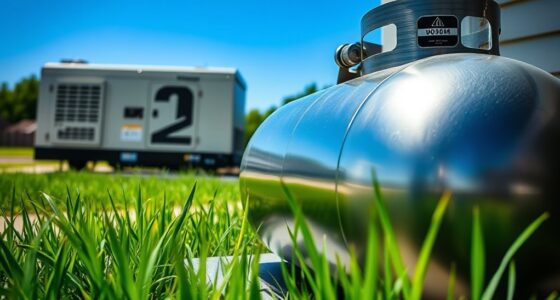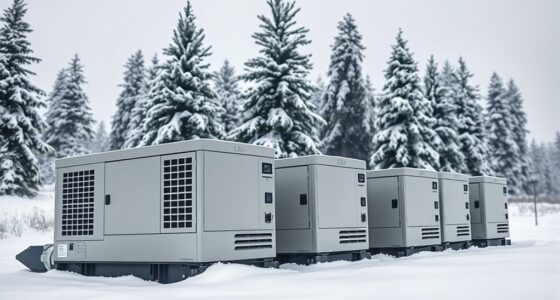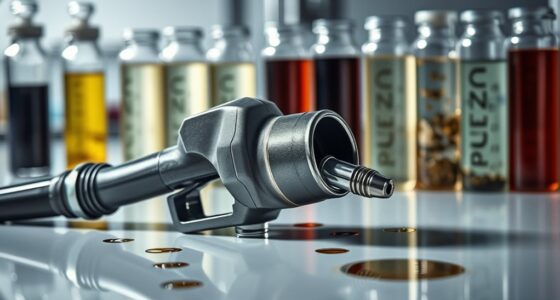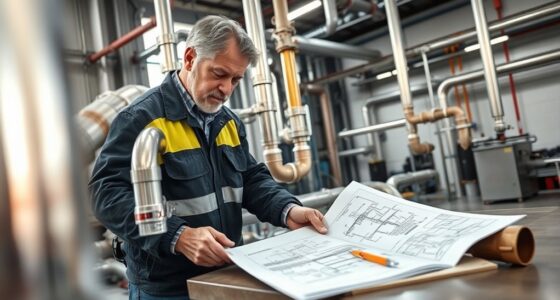To prevent fuel contamination and guarantee quality, always use approved, airtight storage tanks in cool, dry places, and add stabilizers if storing fuel long-term. Keep tanks sealed tightly and inspect regularly for leaks or sediments. Use high-quality fuels and additives, avoid overfilling during refueling, and handle fuels carefully with clean equipment. Regular testing and maintenance help keep your fuel pure and your engine running smoothly—discover more tips to protect your engine for the long haul.
Key Takeaways
- Use certified, high-quality fuels with proper additives to ensure safety and prevent engine damage.
- Store fuel in clean, airtight containers in cool, dry locations to maintain freshness.
- Regularly inspect storage tanks for leaks, corrosion, and contamination, cleaning as needed.
- Add stabilizers before long-term storage and avoid overfilling to reduce microbial growth.
- Conduct periodic fuel testing and maintain proper handling practices to detect and prevent contamination early.
Understanding Different Types of Fuels and Their Uses
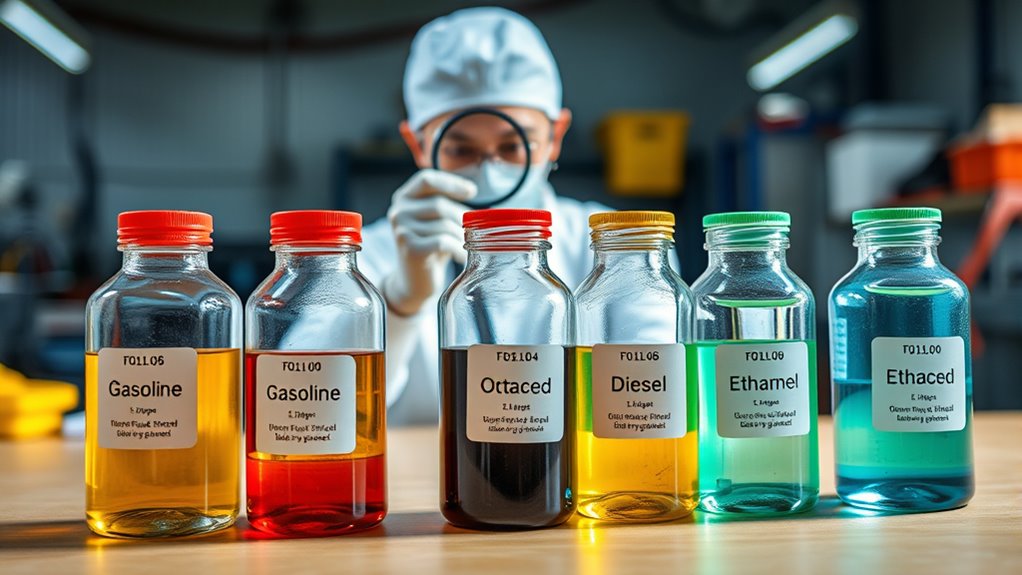
Understanding the different types of fuels and their uses is vital for maintaining ideal engine performance and preventing contamination. Different fuels, like gasoline, diesel, and alternatives, are designed for specific engines and conditions. Knowing which fuel is appropriate helps guarantee efficient operation and longevity. Fuel certification plays a fundamental role here; it guarantees the fuel meets safety and quality standards, reducing risks of engine damage or contamination. Additionally, fuel additives can enhance fuel properties, such as improving stability, cleaning injectors, or preventing corrosion. Using certified fuels with the right additives ensures your engine runs smoothly and reduces the chance of contamination from impurities or poor-quality sources. Being aware of these distinctions keeps your engine in top shape and extends its lifespan. Incorporating fuel quality standards and proper storage practices further minimizes contamination risks and preserves fuel integrity over time.
Proper Storage Techniques to Maintain Fuel Quality
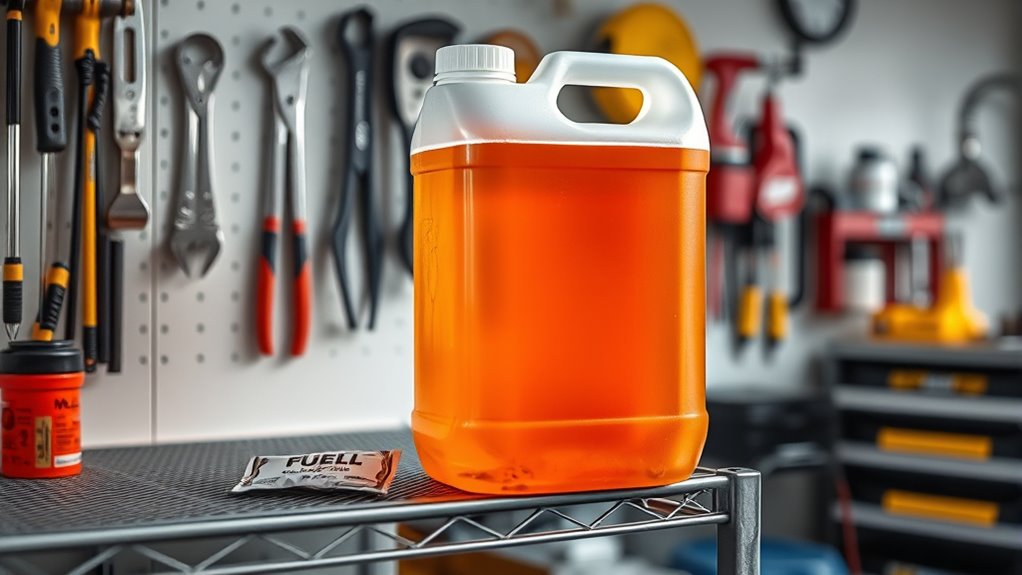
Proper storage techniques are essential to keep your fuel fresh and prevent contamination. Always use a clean, airtight storage tank made of approved materials to avoid moisture and dirt buildup. Position the tank in a cool, dry place away from direct sunlight, which can degrade fuel quality. Before filling, add a fuel additive designed to stabilize fuel and prevent microbial growth. Ensure the tank is sealed tightly after each use to limit air exposure that can cause oxidation. Regularly inspect for leaks or corrosion, and clean the tank periodically to maintain its integrity. Properly stored fuel remains fresh longer, reducing the risk of contamination and engine issues. Additionally, understanding the importance of fuel stability and appropriate storage methods can help maximize your fuel’s lifespan. Following these steps helps preserve fuel quality, saving you money and hassle in the long run.
Common Sources of Fuel Contamination and How to Avoid Them
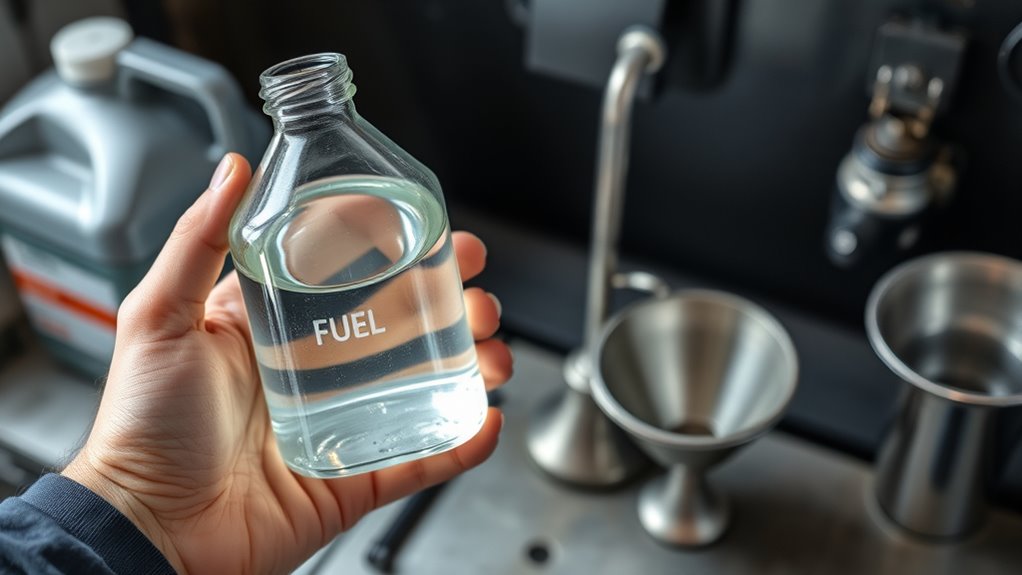
Fuel contamination can originate from several common sources that threaten engine performance and longevity. One major source is water intrusion, which can occur through condensation or improper storage, leading to rust and microbial growth. Dirt and debris also pose risks, often entering fuel during refueling or from contaminated containers. Using low-quality or expired fuel additives can introduce contaminants or fail to prevent them effectively, undermining contamination prevention efforts. Storage tanks with poor sealing or infrequent maintenance may accumulate sludge or sediment, further contaminating fuel. To avoid these issues, always use high-quality fuel additives designed for contamination prevention, keep storage areas clean, and regularly inspect tanks. Proper handling and vigilant maintenance are essential to keep your fuel clean and your engine running smoothly. Additionally, understanding the importance of Dad and Daughter Bond can motivate you to care for your equipment as you would your loved ones, ensuring it remains in optimal condition.
Best Practices for Fuel Handling and Transfer

To prevent contamination during fuel handling and transfer, you need to follow strict procedures that minimize exposure to dirt, water, and debris. Always inspect containers and transfer equipment for cleanliness before use. Use proper fueling tools, and avoid overfilling tanks to reduce spillage risks. When adding fuel additives, ensure they’re compatible with your fuel type and follow manufacturer instructions precisely. If blending fuels, do so in a controlled environment, mixing thoroughly to prevent separation or contamination. Keep transfer areas dry and free of debris, and store fuels in sealed, clean containers. Proper handling reduces the chance of water or dirt entering the fuel system, maintaining fuel quality. Following these best practices guarantees your fuel remains pure, reliable, and ready for optimal engine performance.
Regular Maintenance and Testing to Ensure Fuel Purity

Regular maintenance and testing are essential for ensuring your fuel remains pure and free from contaminants. Regularly inspect your fuel for contamination signs like water accumulation, sediment, or strange odors. Testing your fuel periodically helps identify issues early, preventing engine problems. Consider adding fuel additives that combat bacteria growth and stabilize fuel quality, especially if your fuel sits unused for long periods. Using quality fuel additives can improve combustion and reduce the risk of contamination. Keep storage tanks clean and sealed to prevent dirt, water, or microbial growth. Routine testing ensures you catch contamination signs before they cause damage. Staying proactive with maintenance and testing helps maintain fuel purity, extends engine life, and keeps your vehicle running smoothly. Incorporating preventive measures aligned with industry best practices can further safeguard your fuel system from potential issues.
Frequently Asked Questions
How Can I Identify Contaminated Fuel Visually or Chemically?
You can identify contaminated fuel through visual inspection and chemical testing. Look for discoloration, cloudiness, or particles in the fuel, which indicate contamination. Chemically, you might notice an unusual smell or perform tests like a water separation test or use test kits to detect water or impurities. These methods help you determine if the fuel is contaminated before it damages your engine, saving you time and money.
What Are the Environmental Impacts of Improper Fuel Storage?
Imagine spilling fuel unknowingly; it leads to environmental pollution, contaminating soil and water, harming wildlife and ecosystems. Improper fuel storage causes resource depletion as pollutants leach into the environment, making cleanup costly and time-consuming. You risk contributing to climate change and health hazards when you neglect proper storage. Ensuring correct storage practices minimizes these impacts, protecting your community, conserving resources, and maintaining a cleaner, safer environment for everyone.
Are There Specific Treatments for Contaminated or Degraded Fuel?
Yes, there are specific treatments for contaminated or degraded fuel. You should use fuel additive treatments designed to remove water, stabilize fuel, and eliminate microbial growth. Additionally, perform fuel cleaning procedures like filtering and centrifuging to remove sediments and contaminants. These steps help restore fuel quality, prevent engine issues, and guarantee peak performance. Regularly applying these treatments can extend your fuel’s lifespan and keep your system running smoothly.
How Often Should Fuel Quality Testing Be Performed?
You should test your fuel quality every 3 to 6 months, especially if stored for long periods. Regular testing helps identify contamination or degradation early. Use fuel additives as needed to improve quality and follow proper storage guidelines to prevent issues. By proactively checking fuel, you avoid costly repairs and ensure your engine runs smoothly, maintaining ideal performance and extending fuel life.
What Safety Precautions Are Necessary During Fuel Handling?
Imagine you’re a modern-day alchemist, handling volatile fuel. Always wear protective gear like gloves and goggles during fuel handling, and work in well-ventilated areas to prevent fumes buildup. Follow strict safety protocols, such as grounding containers to prevent static sparks, and keep fire extinguishers nearby. Never smoke or use open flames around fuel. These precautions keep you safe from fire, spills, and harmful fumes during fuel handling.
Conclusion
By understanding fuel types, storing them properly, and handling with care, you can keep your fuel pure and your equipment running smoothly. Regular maintenance and testing are the safety nets that catch issues before they become costly problems. Remember, it’s better to be safe than sorry—don’t let contamination sneak up on you. Stay vigilant, follow these tips, and you’ll be ahead of the game, ensuring peak performance every time.


